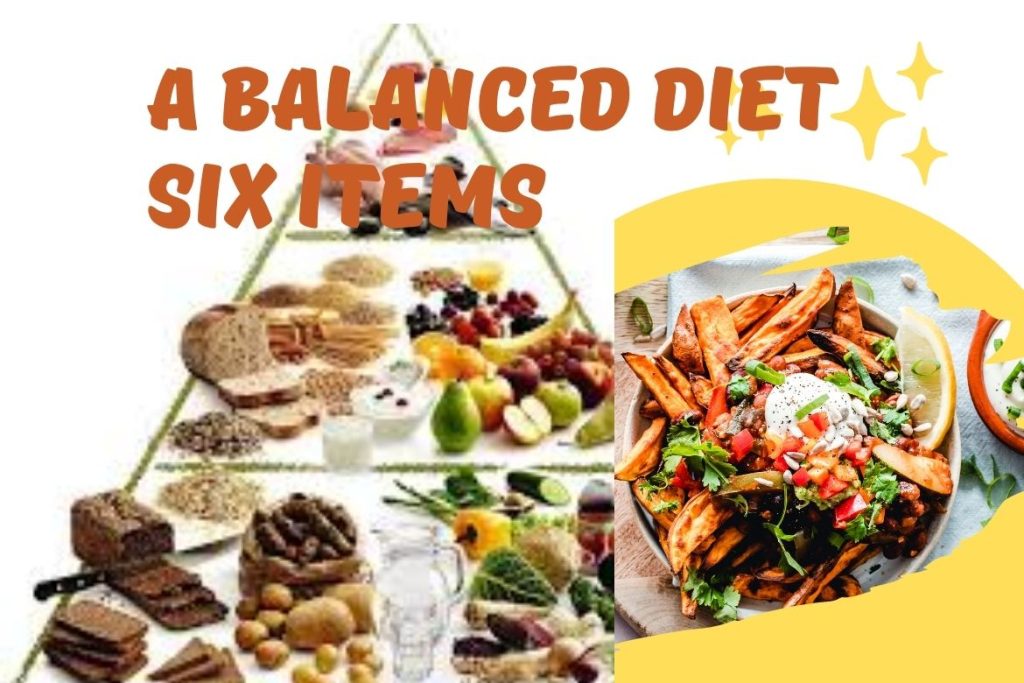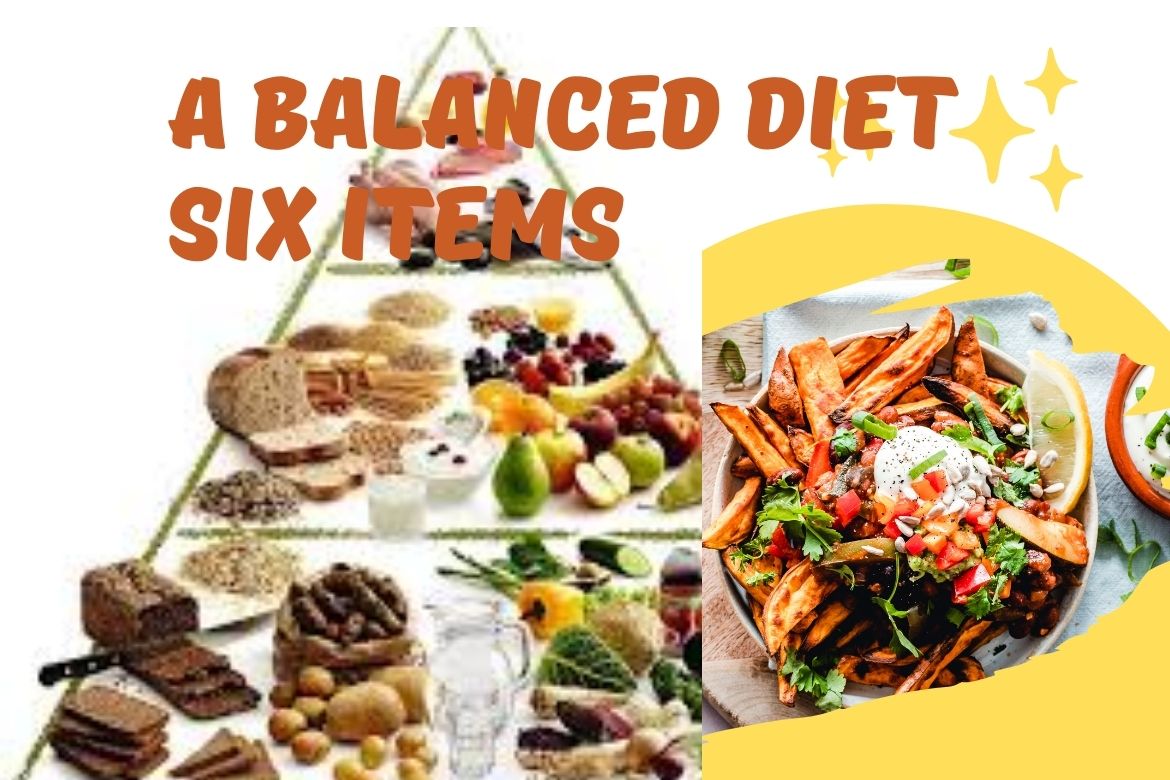A balanced diet food list helps us survive well. The foods that we eat must have proper nutrition that our body needs to grow, keep aloof from diseases, and keep fit. Some people like rich dishes, while some are fond of normal ones. Again, some people may be quite happy with ordinary food. Taste, nutrition, and necessity are inseparably linked to food. Food provides sufficient energy to the human body for work. A balanced diet builds up your body by providing nutrition proportionately and helping you to be a great Type A Personality or Extrovert.
- Carbohydrates: A Balanced Diet: 6 items of Food
- Kinds of Carbohydrates
- What are Dietary Sources of Carbohydrates?
- Role of Protein in a balanced diet food list
- What are the Primary Sources of Protein?
- What are the Animal Sources of Protein?
- A Balanced Diet: 6 items of Food
- Functions of Fats in a balanced diet
- Types of Fats
- Do Animals’ Fats Dissolve?
- What is Triglycerides?
- Water: A Balanced Diet: 6 items of Food
- Which parts of the Human Body control Water?
- Mineral Salt: A Balanced Diet: 6 items of Food
- Vitamins: A Balanced Diet: 6 items of Food
- Do Vitamins Dissolve?
- Enzymes
- Necessity of Enzymes
Carbohydrates: A Balanced Diet: 6 items of Food
Carbohydrates are foods made from various types of sugar, such as glucose and starch that we can find in foods such as bread, rice, and potatoes. Carbohydrates are plentiful in starchy foods such as bread and rice. The body burns carbohydrates to keep it warm and to provide energy for growth and muscle movement, as well as to maintain basic body processes. Plants, for instance, make carbohydrates when they absorb energy from sunlight.
Kinds of Carbohydrates
Carbohydrates are made from chains of sugars and are classified as simple and complex. Simple carbohydrates, such as glucose, fructose, and sucrose, are sweet and soluble, or they dissolve in water. Complex carbohydrates/polysaccharides are made when the molecules of simple carbohydrates join together.
What are Dietary Sources of Carbohydrates?
Dietary sources of complex carbohydrates include whole cereal grains, potatoes, and rice. Bread is very rich in complex carbohydrates, as well as simpler ones such as glucose and sucrose. Our body turns carbohydrates into glucose for use at once or stores them in the liver as the sugar glycogen. Complex carbohydrates are converted into glucose more slowly than simple carbohydrates. Enzymes are used by the digestive system to break complex carbohydrates such as starch into simple sugars that can be absorbed into the blood. Saliva/spit contains the enzyme amylase, which converts starch into glucose.
Role of Protein in a balanced diet food list
Proteins are essential to the structure, function, and regulation of the body. They account for 10 to 30 percent of our body weight. Proteins are made from strings of amino acids, which are molecules containing carbon, hydrogen, nitrogen, oxygen, and sometimes sulfur. There are 20 common types of amino acids, of which nine we must eat because they cannot be made in the body. These are called essential amino acids. Our body cannot store protein, so we need to eat a little every day.
What are the Primary Sources of Protein?
Protein in the diet comes from meat, cheese, eggs, yogurt, beans, soy, cereals, nuts, and seeds. Protein in the diet is broken down in the digestive system into amino acids that can be absorbed into the blood and then made into new proteins. An adult man needs to eat about 2 ounces of protein a day while an adult woman needs to eat about 1.5 ounces a day. Women need more proteins when they are pregnant, or breast-feeding.
What are the Animal Sources of Protein?
Animal sources of protein contain all the essential amino acids, while plant proteins do not. Proteins are needed to build and repair cells and are made from chemicals called amino acids. There are 20 different amino acids. Your body can make 11 of them. The other nine are called essential amino acids and come from food. A correctly balanced vegetarian diet can provide all the essential amino acids. Fiber, or roughage, is supplied by cellulose from plant cell walls. Your body cannot digest fiber but needs it to keep the digestive system working properly.
A Balanced Diet: 6 items of Food

Fats are greasy foods that will not dissolve in water. Some, such as the fats in meat and cheese, are solid. Some, such as cooking oil, are liquid. Fats are not usually burned up right away, but stored in your body until they are needed.
Functions of Fats in a balanced diet
Fats are an important source of energy. Together with proteins and carbohydrates, they make up our body’s three main components of foods. While carbohydrates are generally used for energy immediately, our body often stores fat to use for energy in times of shortage. Ounce for ounce, fats contain two-fold energy as carbohydrates. Fats, or lipids, are important organic substances, found in almost every living thing. They are made from substances called fatty acids and glycerol.
Types of Fats
Fats are either saturated or unsaturated. Cheese is a saturated fat, which means its fatty acids are saturated with as much hydrogen as they can hold. Saturated fats are linked to high levels of cholesterol in the blood and may increase certain health risks, such as heart attacks.
Do Animals’ Fats Dissolve?
Food fats are vegetables or animal fats that don’t dissolve in water. Most vegetable fats are liquid, although some nut fats are solid. Most animal fats are solid. Milk is mainly water with some solid animal fats. Most solid fats melt when warmed.
What is Triglycerides?
Fats called triglycerides are stored around the body as adipose tissue. These act as energy stores and insulate the body against the cold. Fats called phospholipids are used to build body cells. In our stomach, bile from our liver and enzymes from our pancreas break down fats into fatty acids and glycerol. These are absorbed into our body’s lymphatic system or enter the blood. View at Amazon,
Water: A Balanced Diet: 6 items of Food
Pure water is life. However, this water must be pure for the human body. We can survive for weeks without food, but no more than a few days without water. We gain water by drinking and eating and as a by-product of cell activity. We lose water by sweating and breathing and in our urine and feces. The average adult takes in about 9 cups of water a day: around 6 cups from drinks and 3 cups from food. The average adult loses 6.5 cups of water every day in urine, 2.5 cups in sweat, 1.5 cups as vapor in breath, and 1.5 cups in feces.
Which parts of the Human Body control Water?
The kidneys and adrenal glands control the balance of water in our body. Our kidneys extract waste and surplus water from our blood to make urine, which is stored in the bladder. The amount of water the kidneys release as urine depends on the amount of salt in the blood. If we drink a lot, the saltiness of the blood is diluted. To restore the balance, the kidneys let out water in the form of urine. If we drink little or a little but sweat a lot, the blood becomes more salty, so the kidneys restore the balance by holding on to more water.
Mineral Salt: A Balanced Diet: 6 items of Food
Organic foods have mineral salts. Mineral salt is essential for digesting food. Before eating, eat a pinch of salt. The upper jaws of our mouth create saliva, which creates many enzymes and helps food digestion.
Vitamins: A Balanced Diet: 6 items of Food
Vitamins are special substances the body needs to help maintain chemical processes inside cells. Plants can make their vitamins, but humans must take most of their own from food. A lack of any vitamin in the diet can cause illness. The first vitamins discovered were given letter names such as B. Later, discoveries were given chemical names. Before the 18th century, sailors on long voyages used to suffer from the disease scurvy, caused by a lack of vitamin C from fresh fruit in their diet.
Do Vitamins Dissolve?
Some vitamins, such as A, D, E, and K, dissolve in fat and are found in animal fats and vegetable oils. They can be stored in the body for months. Some vitamins, such as C and Bs, dissolve in water and are found in green leaves, fruits, and cereal grains. They are used by the body daily. Vitamins D and K are the only ones made in the body. Vitamin D is made by the skin when exposed to sunlight—15 minutes three times a week may be enough. Read more.
Enzymes
Enzymes are molecules, mostly proteins that alter the speed of chemical reactions in living things. There are thousands of enzymes in our body. It could not function without them. Some enzymes need an extra substance, called a coenzyme, to work. Many coenzymes are vitamins. Most enzymes have names ending in ‘’ase’’, such as ligase, protease, and lipase. Pacemaker enzymes play a vital role in controlling our metabolism—the rate at which our body uses energy.
Necessity of Enzymes
The activity of an enzyme is easily destroyed by heat. This is one reason why the body must be kept at a constant temperature of 98 Degrees Fahrenheit. Many enzymes are essential for the digestion of food, including lipase, protease, amylase, and peptidases. Most of these are made in the pancreas. Lipase is released mainly from the pancreas into the alimentary canal to help break down fats. Amylase breaks down starches, such as those in bread and fruit, into simple sugars. There is amylase in saliva and in the stomach. In the gut, the sugars maltose, sucrose, and lactose are broken down by maltase, sucrose, and lactase.


